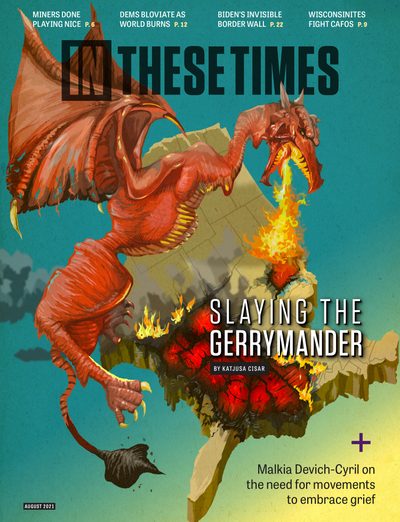Is Gerrymandering Forever?
Gerrymandering guarantees undemocratic elections. Activists in Wisconsin are organizing to win an uphill battle for a fairer process.
Katjusa Cisar

This article is part of The Wisconsin Idea, an investigative reporting initiative focused on rural Wisconsin.
High school student Michael Nichols became an activist against gerrymandering as he was wrapping up his senior year in spring 2020.
“All of a sudden in quarantine I got this energy,” the northwest Wisconsin resident says. Nichols believes that gerrymandering — the process of redrawing electoral districts in an intentionally partisan way — is a major roadblock to any meaningful state and federal legislation on climate change, which he considers the most important issue of our time.
States redraw their electoral maps every 10 years (the next time being 2021) based on data from the U.S. Census Bureau. Congressional districts all represent roughly the same number of people (about 700,000), so population changes demand the districts be reviewed after the new census data comes out. The redistricting process itself is a balancing act of retaining geographic compactness, respecting existing boundaries (such as county lines and school districts), following federal laws (against racial discrimination, for example) and trying to keep communities with shared policy interests grouped together.
The process in Wisconsin leaves the once-a-decade job to state legislators, but Nichols focused in on a bill to amend the state constitution to instead designate a nonpartisan body to draw up electoral maps.
First, Nichols contacted Republican politician David Armstrong, who was campaigning at the time to represent Nichols’ home district in the Wisconsin State Assembly (and started his first term in January). Nichols had a simple question for Armstrong, and asked, using Facebook Messenger: “Are you in favor of the bipartisan bill for nonpartisan redistricting in our state?”
Armstrong promised to get back after he had a chance to read the bill. But a week passed, then another. Several reminders later, Armstrong finally offered a noncommittal reply and asked Nichols what he thought. (Nichols shared screenshots of the conversation with In These Times.)
Nichols explained that gerrymandered districts make it less likely that legislators will work together on urgent issues, such as climate change. Again, Nichols requested Armstrong’s take: “I want to know if you, as my possible representative, would support the bill that would help end gerrymandering.”
Armstrong promised to “look at it” but made clear that nonpartisan redistricting would be a low priority. “I can see you are very liberal in your issues and would more than likely support a liberal candidate,” Armstrong added.
Nichols considers himself an independent voter — someone who goes “back and forth on many issues” — rather than a liberal. Reflecting back on the conversation, Nichols says he was “very shocked” at how Armstrong “labeled me and then kind of pushed me to the side.”
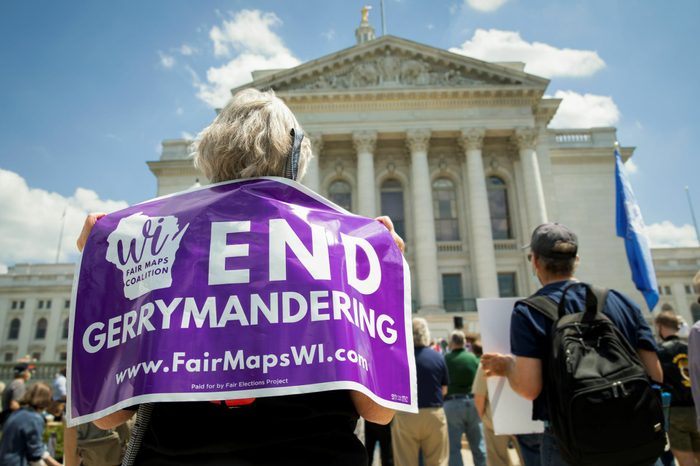
Wisconsin’s nonpartisan redistricting bill failed in April 2020, but has been reintroduced in the current session. In Iowa, nonpartisan legislative staff are primarily responsible for redistricting, consulting the public at statewide hearings and following strict rules that prohibit the use of demographic and voting data. This is a model that many anti-gerrymandering activists favor.
In most states, the state legislature, a partisan body, is tasked with drawing the maps. After Obama’s 2008 election, Republican leadership began to plan an extreme nationwide gerrymandering strategy called “REDMAP,” short for “Redistricting Majority Project,” which launched ahead of the midterm elections in 2010. The goal was to cement GOP power against the tide of demographic and social change that is whittling away its voting bloc.
REDMAP worked exceptionally well for Republicans in Wisconsin, a longtime purple state, by locking in a state-level advantage. Even when Republican Gov. Scott Walker lost his 2018 reelection bid by popular vote, for example, he still carried 63 of the 99 Wisconsin State Assembly districts. Now, activists like Nichols want to undo that power grab and replace it with a fairer districting system — one that reflects the interests of constituents, rather than a particular party.
Back in 2011, most Wisconsinites had no idea their districts were being redrawn this way — because GOP leadership worked in secret, hiring an outside consultant to draw the map in a locked room at a private law firm across from the State Capitol at taxpayers’ expense. Even rank-and-file Republicans were barred from entering the room without signing legal agreements not to discuss the maps, according to court documents. (GOP lawmakers tried to shield the documents from public view, but they were forced out during litigation.)
Email correspondence among Republican legislators also revealed blatantly partisan motivations in drawing the districts. In one email, a state senator listed potential Republican-friendly areas, including what she referred to as “cop wards” in the typically Democratic voting city of Milwaukee. It was like the senator “was at a McDonald’s drive-through, ordering up for voters,” said Vicki Aro-Schackmuth, director of the Waukesha County branch of the League of Women Voters of Wisconsin, during public testimony in October 2020.
With this kind of gerrymandered map in play, advocates for nonpartisan redistricting say politicians have little incentive to work across party lines, even on popular issues — such as, ironically, nonpartisan redistricting.
In summer 2020, Nichols brought a resolution to the city council of Barron, the municipality closest to his rural home, that called for a nonpartisan redistricting procedure in Wisconsin and a local referendum to put the issue to voters. The resolution passed unanimously.
In the non-binding city referendum that followed in November 2020, 71% of voters said yes to creating “a nonpartisan procedure for the preparation of legislative and congressional district plans and maps.”
Nichols’ activism for fair maps is part of a grassroots movement, gaining momentum since 2017, of fed-up voters across rural and urban Wisconsin. Too often dismissed by state legislators, these activists are instead spreading their message through resolutions and referendums at the city and county level, with letters to the editor in local newspapers and voter-to-voter education. In May, they rallied at the State Capitol.
Statewide, voters in 32 of Wisconsin’s 72 counties have passed referendums (by wide margins) in favor of nonpartisan redistricting, along with 21 municipalities — some as tiny as Manitowish Waters, population 662. Overall, 55 county boards and five municipalities have passed supportive resolutions.
These efforts are legally non-binding, which means the state legislature does not have to listen — unless, as activists hope, judges consider public opinion when the 2021 map (almost inevitably) goes to court in a battle between the GOP-led state legislature and the Democratic governor.
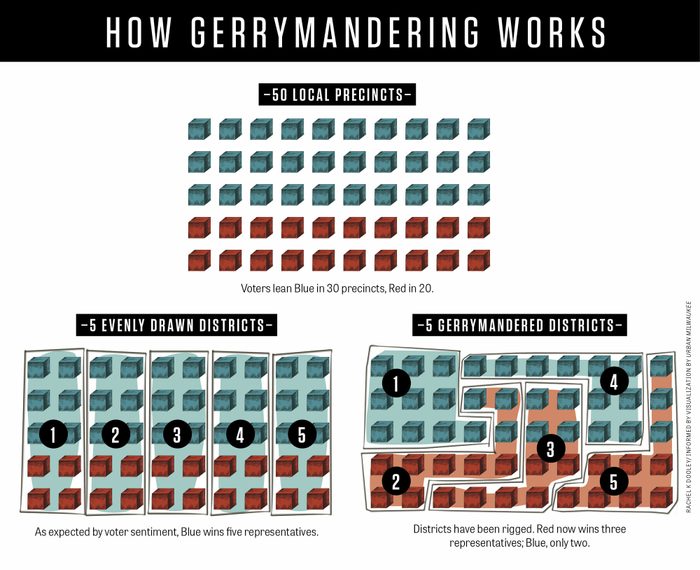
Gerrymandering is not new. The term was coined in 1812 to describe a Massachusetts district so contorted under the administration of Gov. Elbridge Gerry that it looked like a mythological salamander with wings, a “gerry-mander.”
Moon Duchin, a mathematician who leads the Metric Geometry and Gerrymandering Group Lab at Tufts University, calls gerrymandering an “equal opportunity activity.” Maryland, for example, has an “extreme gerrymander” drawn by Democrats, according to the Brennan Center for Justice, a nonpartisan law and policy institute.
But since the Obama era, gerrymandering and other forms of voter suppression have become a coordinated, nationwide Republican strategy. Funded by major corporate donors (including Walmart and Citigroup) and openly discussed among leadership on the Right, REDMAP started in 2010 as a privately funded Republican State Leadership Committee (RSLC) project, and to this day its website openly brags about flipping legislative control in 2010 and the “opportunity to create” new Republican congressional districts through redistricting.
Chris Jankowski, a political consultant who ran REDMAP, defended it at the 2019 National Conference of State Legislatures forum by dismissing efforts for nonpartisan redistricting: “The whole fair map concept is tricky. … I don’t see why the government has to create a commission to say, ‘This is what’s fair.’ ”
According to the University of Southern California, the 2018 state legislative elections established “GOP minority rule” in Virginia, North Carolina, Pennsylvania, Ohio, Michigan and Wisconsin — meaning that, despite winning a minority of voters, the GOP still controlled the legislature. Wisconsin, the analysis found, ranks second (to Virginia) for the worst gerrymander in the country. Virginia voters recently approved redistricting reform, however, effectively bumping Wisconsin to the top battleground for reform.
Now, again bolstered by tax-exempt corporate donations, the RSLC is back with a new REDMAP-like project: Right Lines 2020. It positions itself as a defense against “socialism” and “liberal politicians who seek to silence conservative voices through gerrymandering — for the next decade.”
Republican officials are themselves preparing to treat redistricting as “political adult blood sport,” according to audio leaked to Slate from the 2019 annual meeting of the conservative American Legislative Exchange Council (ALEC). In a closed-door workshop on redistricting, one panelist talked about his success in cornering a Black incumbent Democrat in a mapping “trap” to benefit Republicans. Attendees were advised to toss their notes from the session “if you don’t want it turned over in discovery” in later litigation.
According to anti-gerrymandering activists, the partisan process sours democracy for everyone — by confusing voters, splitting communities, amplifying hyper-partisanship, insulating legislators from voter accountability and stalling problem-solving efforts.
And if voters are the losers, then lobbyists and ideological groups are the winners. Gerrymandering efforts have been connected to the passage of extreme policies that don’t have broad voter support, such as six-week abortion bans, anti-union laws and dismantled employee rights.
Like Jim Crow-era restrictions on voting, gerrymandering often weakens the power of voters of color. In Milwaukee, for example, a map drawn by Republicans created a district that crossed a county line, roping thousands of Black and Latino residents into a district dominated by white suburbanites. This tactic, known as “cracking,” dilutes the potential formation of an oppositional voting bloc. Efforts to “pack” Black voters into a small number of districts in North Carolina were blocked by a 2017 Supreme Court decision, which found North Carolina had racially discriminated against non-white voters in its electoral maps. (In Georgia, an NAACP lawsuit alleging racial gerrymandering was dismissed in 2017 on the grounds that the case proved “discriminatory intent” but failed to prove a “discriminatory effect.”)
Unlike crude voter suppression tactics such as poll taxes, literacy tests and physical intimidation, gerrymandering is an increasingly slick and technologically advanced process. As Atlantic senior editor Vann R. Newkirk II put it, today’s political mapmaking “is a multimillion-dollar enterprise, with dozens of high-profile paid consultants, armies of lawyers, terabytes worth of voting data [and] advanced software.”
But voters are catching on.
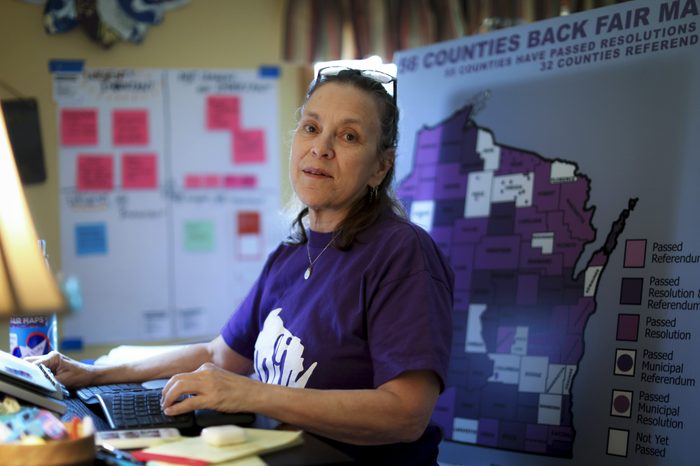
There was a time when nobody knew what gerrymandering meant,” says Carlene Bechen, organizing director for the Wisconsin Fair Maps Coalition, a grassroots movement to pass nonpartisan redistricting.
Now, a search for “gerrymandering explained” on YouTube brings up dozens of visual explanations using pennies and dimes, blue and red dots, jungle animals, pepperoni pizza and clips from The Simpsons. Bechen’s strategy as an organizer is to engage people in the redistricting process itself. “When you talk to people about the issues they care about, they get that the legislature is out of balance” and unresponsive to voters, she says.
She remembers the pivotal moment she first saw the real-life effects of gerrymandering.
In 2017, Bechen testified at a state-level Joint Committee on Finance budget hearing in Platteville, Wis. It was in a school gym, with committee members sitting “up on a dais at the front.” For 10 hours, the committee heard two-minute testimonies from constituents, overwhelmingly in favor of increasing public education funding.
Public education funding has strong bipartisan support, but the closure of rural schools continues to “decimate rural communities” and the lack of infrastructure continues to hobble urban schools, Bechen says.
At the hearing, it bothered her when committee members got on their phones, as if they weren’t seeing or hearing their constituents. But she says her real anger came when the lawmakers passed a budget that ignored the hearing and allotted “a pittance” to public education.
“That’s the piece that’s more demoralizing and humiliating,” Bechen says. That’s when she realized, “My pleas didn’t matter.” (In the spring, Bechen won office as a write-in candidate for her village board of trustees. She was a “reluctant candidate at best,” she says, but “someone needed to step up to do it. We need people who’ve been paying attention.”)
As of 2020, Wisconsin voters have a new outlet for airing their hopes and frustrations on redistricting: the People’s Maps Commission. The nine-member panel was created by executive order from Gov. Tony Evers (D) to take public input and create new district maps for the Wisconsin legislature to review (though under current Wisconsin law, the legislature is not bound to accept the maps). No one on the panel is an elected official, lobbyist or political party official, and they come from across Wisconsin’s congressional districts.
In the hours of public testimony before the commission in 2020 and earlier this year, one theme emerged: Elected representatives no longer visit, listen to or care about their constituents. Some voters attributed this neglect to the 2010 gerrymander and the dark money that flowed in with it.
“Our voices now go unheard,” an 8th Congressional District resident said. Instead of engaging, her representative sent her a “patronizing form letter.”
Meanwhile, issues “we all agree on” get no action, said Chrysa Ostenso, who runs an optometry clinic in northern Wisconsin. She blames outside money for “why we can’t have Medicaid expansion, which polls high.”
Gerrymandering “explains why the Wisconsin state legislature can get away with doing nothing meaningful about Covid,” a 7th Congressional District resident, Grace Coggio, testified. Her congressman sent out an “insulting survey” at taxpayers’ expense with biased yes/no questions about policing, education and the national debt, just to get “an affirmation of his agenda,” she said.
Brian Ewert, a Marshfield physician who made a failed bid in 2018 to unseat the Republican 7th Congressional District incumbent, lamented that legislators “know they will always be reelected” and their party allegiance takes precedence over voters.
“We have a scorched earth legislature,” Vik Verma, vice chair of the Lincoln County Democrats, testified. He told the commission he moved to Wisconsin from Texas, where gerrymandering “pales in comparison” to Wisconsin — and where he was at least able to have relationships with his Republican representatives.
With a Republican legislature and Democratic governor in power, Wisconsin’s 2021 map is almost certain to end up in court, just as it has every other time in the past 70 years (with the exception of 1971). Wisconsin’s 2011 redistricting case — whose lead plaintiff, William Whitford, famously stated, “In a democracy citizens are supposed to choose their legislators. In Wisconsin, legislators have chosen their voters” — ultimately made it to the U.S. Supreme Court, where it died. A lower court had agreed with the plaintiffs that partisan gerrymandering was unconstitutional, but the Supreme Court ruled no harm had actually come of it in this case — Whitford was a Democratic voter in a Democratic district, after all — and punted the issue.
Ultimately, Wisconsin’s new districts remained unchanged. Republicans have retained control, even when losing the statewide aggregate vote, and turned the traditionally purple state red.
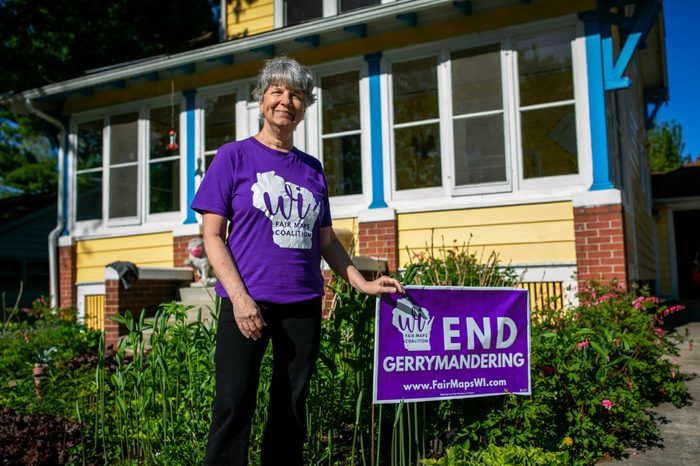
Prior to the 2011 redistricting, Wisconsin Democrats could have passed laws to prevent gerrymandering, “but they wanted to rig the maps themselves,” according to Sachin Chheda, director and cofounder of the Fair Elections Project.
Nonpartisan redistricting advocates don’t see gerrymandering as a partisan issue, however.
“Years of frustration of not feeling heard by legislators” is what motivates Patti Herman, a Fair Maps Coalition organizer in Columbia County. She says her representatives “blew it off ” when she brought up fair maps at a listening session.
Her home used to be in the 2nd Congressional District, which includes Madison, Wis. It made sense because many Columbia County residents commute the 35 to 45 minutes into the capital. After 2011, Columbia County was switched to the 6th District, lumped in with areas as far north and east as the Lake Michigan port city of Manitowoc, two hours away.
“They’ve rigged the maps across the state,” Herman says. She wants to keep gerrymandering in the public eye so “[legislators] know the people of Wisconsin are watching.”
“You might notice there’s a lot of letters to the editor,” Herman adds. “This is not a one-time concern. This isn’t the flavor of the month.”
Lena Eng, a conservative Christian and longtime Republican in Waukesha County, is the executive director of Voters First Wisconsin. She was inspired to push for nonpartisan redistricting after 2011 to help elect “uniters” to find bipartisan solutions for healthcare, education, foreign debt, immigration and criminal justice reform.
Eng says she respects her Republican representatives, both of whom came into office after the most recent redistricting, but resents being used “as a pawn to turn a blue district red.”
“Politics should be about debating the best ideas, not about demonizing the other side and creating fear,” Eng says. “Fear seems to work, but it’s not what’s healthy for democracy. We’re Americans before we’re Republicans or Democrats.” In her organizing, she says, “It’s been a joy to be able to work alongside the political spectrum.”
Eng also says it’s been a challenge to get fellow conservatives energized about nonpartisan redistricting because the issue “gets downplayed by Republicans.” But she’s heartened by the 2019 Marquette University Law School survey that shows broad overall voter support.
“I think we have to get more people to recognize that the problem is not the other side,” Eng says. “The problem is the system. … I want to compel my conservative brothers and sisters to do the right thing.”
As the American-born daughter of Taiwanese immigrants, Eng is aware of not looking “like white America,” she says, but now is the time to “show the world that we can be diverse in so many ways and still lead the way in democracy.”
For advocates of nonpartisan redistricting, the 2021 maps are pivotal. An analysis by RepresentUs, a nonpartisan group focused on election reform, found more than half of U.S. states are at risk of “extreme gerrymandering,” while the risk is low in the handful of states where voters have successfully pushed for stronger protections, such as Michigan.
State GOP leaders in Wisconsin argue Republicans simply have a natural geographic advantage because Democrats are more concentrated in cities, but the federal judges who ruled against that logic said it “does not explain adequately the sizeable disparate effect” in elections.
Regardless, many rural residents do not feel spared the effects of gerrymandering.
The Wisconsin Farmers Union, a member-driven advocacy organization founded in 1930, has also taken up the cause. In the climate of “extreme partisanship” created by gerrymandering, Julie Keown-Bomar, executive director, sees issues important to farmers — such as water quality, local control and rural broadband access — get lopsided influence from outside lobbyists. Gerrymandering “just makes it really safe [for legislators],” she says.
Keown-Bomar also pushes back against the notion of the rural-urban political divide. “It’s so simplistic,” she says. “I think the divide is often played out politically out of self-interest. I think we need a much stronger focus on solidarity if we’re going to get anything to happen.”
In October, Keown-Bomar partnered with Angela Lang, a star organizer in Milwaukee and executive director of Black Leaders Organizing for Communities, to write an op-ed in support of voter rights.
“Because these politicians know that our government does not serve the vast majority of Wisconsinites, they use hate, division, resentment and anger as a wedge to divide us,” Keown-Bomar and Lang wrote.
“But we aren’t taking the bait. This election season, we’re joining together — Black and white, from the North Side to the Northwoods — to call for a fair election that counts everyone.”
Maryum Elnasseh contributed fact checking to this feature.
Katjusa Cisar is an independent journalist based in Wisconsin.
